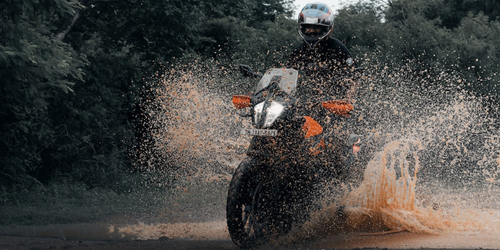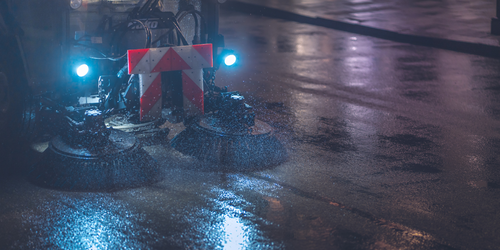Monsoon Biking: How to Stay Safe and Comfortable on Wet Roads

1890 Views
Learn how to ride a bike in monsoon like a pro with these tips, precautions, gear and maintenance. Find out how to prepare yourself and your bike for wet roads, how to avoid accidents and how to enjoy the beauty of nature.

The monsoon season is upon us and it brings with it a welcome relief from the blazing summer heat. But it also brings some challenges for bikers who have to brave the wet and slippery roads, the low visibility and the unpredictable weather.
To ride a motorcycle in monsoon, you need to be extra careful and prepared to ensure your safety and comfort.
Here are some tips on how to do that, along with the precautions to take, the gear to wear and the maintenance to do.
Monsoon Mentality:

Before we get into the nitty-gritty of riding in monsoon, let’s talk about how it affects your mind. Monsoon can have a big impact on your mood and motivation for riding a bike. Some bikers may love the thrill and challenge of riding in the rain, while others may dread it and feel stressed.
Monsoon can also make you feel more alive and refreshed after a ride, as you soak in the beauty and freshness of nature. To cope with the mental effects of monsoon, you can try to have a positive outlook, listen to some upbeat music or podcasts, or ride with a buddy or a group for fun and support.
Precautions to Take

Safe Speed: Your speed is your enemy on wet roads. It reduces your braking efficiency and increases your stopping distance. So make sure you ride at a lower speed than usual and keep a safe distance from other vehicles . Avoid sudden braking or acceleration and use both brakes smoothly and progressively.
Driving Terrain: Your road is your challenge on wet roads. It may be uneven, slippery or covered with mud, oil or debris. These can make you skid or lose control of your bike. So be careful on curves, corners and intersections. These are the hotspots for accidents during monsoon. To avoid them, slow down before entering a curve or corner and lean your body rather than your bike. Also, be alert at intersections and watch out for pedestrians, cyclists or other vehicles that may cross your path unexpectedly.
Avoid riding through puddles, potholes or flooded areas. These can hide dangerous obstacles or damage your bike’s engine, electrical system or suspension. If you have to ride through them, do it slowly and carefully, keeping your feet on the pegs and your eyes on the road ahead. After crossing a puddle or a flooded area, test your brakes gently to make sure they are working properly.
Gear to Wear
Waterproof Gear:Wear waterproof clothing and accessories. Nothing can spoil your ride more than getting drenched in rain. So invest in some good quality waterproof gear that can keep you dry and warm. This includes a rain jacket, pants, gloves, boots and helmet. You can also wear a rain suit over your regular riding gear for extra protection. Make sure your gear fits well and does not restrict your movement or vision.
Visibility Gear: Wear bright or reflective clothing. Visibility is another big issue during monsoon. The rain, fog and mist can reduce your visibility and make you less visible to other road users. To avoid this, wear bright or reflective clothing that can enhance your visibility and make you stand out. You can also use reflective tape or stickers on your bike or helmet for added visibility.
Anti-fog Gear:Wear anti-fog visor or goggles. Fogging is another common problem that affects your vision when riding in the monsoon. Fogging occurs when the warm air inside your helmet meets the cold air outside. To prevent this, wear an anti-fog visor or goggles that can prevent condensation and keep your vision clear. You can also use anti-fog spray or wipes on your visor or goggles before you ride.
Maintenance Tips
Chains: Your chain is your lifeline on your bike. It connects your engine to your wheels and transfers the power and torque. But it also gets dirty and rusty during monsoon due to the water and mud. To avoid this, you need to clean and lubricate your chain regularly. Use a brush and water to scrub off the dirt and grime from your chain after every ride and apply a good quality chain lube to keep it smooth and shiny. This will prevent corrosion and improve the performance and life of your chain.
Brake Pads: Your brake pads are your saviors on wet roads. They help you stop or slow down your bike when you need to. But they also get worn out faster during monsoon due to the frequent braking on the slippery surface. To ensure effective braking and safety, you need to check and replace your brake pads if needed. Look for signs of wear and tear on your brake pads and change them if they are too thin or damaged. You can also adjust the brake lever for better feel and control.
Tire: Your tires are your best friends on wet roads. They help you grip and balance on the slippery surface. So make sure you check your tire condition and pressure before you ride. Your tires should have enough tread depth to channel water and prevent hydroplaning. Also, check the tire pressure and adjust it according to the manufacturer’s recommendation or slightly lower for better traction.
Electric parts: Your bike’s electrical system is your brain and nervous system. It controls your bike’s functions and features, such as the ignition, horn, lights, etc. But it is also vulnerable to water and moisture damage, which can cause short circuits or malfunctioning if exposed to them.
To avoid this, you need to protect your bike’s electrical system from water damage. Cover your bike’s battery, spark plug, ignition switch, horn and lights with plastic bags or tape. You can also apply dielectric grease on the electrical connectors and terminals to prevent corrosion and improve conductivity.
Check out our detailed video on the same topic, on our YouTube channel.
Conclusion
Riding a motorcycle in monsoon can be a blast if you follow these tips and precautions. Remember to get yourself and your bike ready before you ride and be careful and vigilant on the road. Also, don’t forget to carry a first-aid kit, a tool kit and a spare tyre in case of emergencies. Happy riding!
